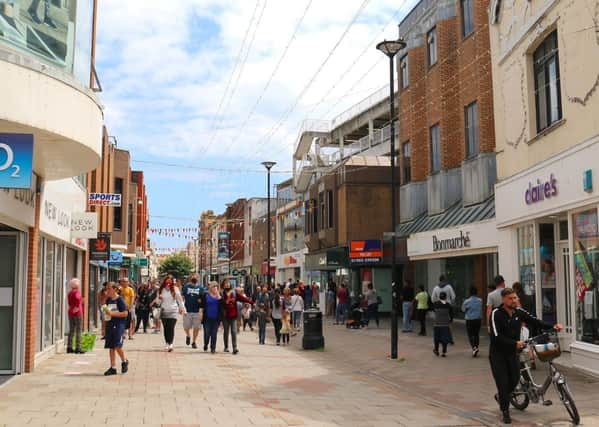How can girls and women feel safer in Adur and Worthing’s public spaces?


The Adur and Worthing Safer Communities Partnership was discussed during a meeting of the councils’ joint overview and scrutiny committee (JOSC) on Thursday (October 14).
The aim of the partnership is to reduce crime and disorder through joint working between the councils, Sussex Police, the local NHS trust and other organisations.
Advertisement
Hide AdAdvertisement
Hide AdThe partnership is currently undergoing a review to identify its priorities up to 2024 and the councils’ executive members for health and wellbeing were present at JOSC meeting to answer questions.
Issues highlighted during the meeting included the effects of crime on young women and girls.
This included the involvement of young girls in crime and the threat to womens’ safety across Adur and Worthing.
Womens’ safety highlighted
Worthing councillor Louise Murphy (Con, Offington) asked what was being done through the partnership to promote the safety of women, especially in light of Sarah Everard’s murder.
Advertisement
Hide AdAdvertisement
Hide AdAdur executive member for health and wellbeing Kevin Boram (Con, Buckingham) said it was something he ‘thinks about all the time’ as a father to two daughters.
Mr Boram said that the partnership had seen work with the night time economy and consultation carried out with all women panels with regards to planning applications.
“Clearly all the partners we work with are aware of this,” he said, “Not only the police and the people who are directly involved in crime, but the pubs and the night time economy in making sure women leave a pub or a bar safely if they’re intoxicated.
“In major planning applications in Adur I’ve asked that they are reviewed by a panel of women.
Advertisement
Hide AdAdvertisement
Hide Ad“How something is designed, how an open space, how a community space is designed is perceived completely differently by a woman than a man.
“So I’ve been trying to get as many women to be involved in the design and what we do about this because they’re the people with the experience, they’re the people with the real fears.”
Carl Walker (Lab, Selden) pointed out that both executive members Kevin Boram and Sean McDonald (Con, Northbrook) are male.
He said: “For too many years, men have made a lot of decisions around women’s safety and I wondered how you guys are educating yourselves around this.”
Advertisement
Hide AdAdvertisement
Hide AdMr Boram said that women’s involvement ran ‘right the way through’ the partnership and said it was important for ‘men to listen to other voices’.
He added: “My ambition – whether we get this in my lifetime or not – is that anybody can leave their front door, place of work, place of entertainment at any time of the night, any time of the day and feel safe doing what they want to do.”
Adur committee chair Joss Loader (Ind., Marine) said it was ‘equally important’ to ‘educate young men and boys’ on women’s safety.
A young person’s safety questionnaire carried out to inform the safer communities partnership found that 52 per cent of boys often spend time in recreation areas like parks, while only eight per cent of girls did the same.
Advertisement
Hide AdAdvertisement
Hide AdAround 33 per cent of girls said they ‘rarely’ spent time in these spaces compared to 21 per cent of boys surveyed.
None of the boys surveyed said they ‘don’t feel safe at all’ in the spaces whilst 12 per cent of girls did.
Girls also identified a number of ‘no go’ areas including alleyways and poorly lit areas.
When they were asked how safe they felt exercising in public, the average score given out of 10 by the girls was 3.8.
Advertisement
Hide AdAdvertisement
Hide AdThey called for more ‘private areas’ so they would not feel ‘watched’ or ‘objectified’ by adult men.
Young girls involved in crime
Sally Smith also raised the issue of young girls becoming involved in crime – something that was highlighted at a recent Sussex Police and Crime Panel meeting.
She said: “The police were telling us that the trend seems to be for younger and younger girls to be getting involved [in crime] and I just wondered what strategies could be put in place to address this.”
Mr Boram said that the police and the councils have been working with local schools and through youth crime prevention schemes.
Advertisement
Hide AdAdvertisement
Hide AdHe added: “The last thing they want to do is to criminalise these young children.”
Worthing executive member for health and wellbeing Sean McDonald called this ‘a really worrying trend’.
He said: “This is a really worrying trend and it’s been going on for a while.
“When I was in the police, we had undercover police officers infiltrating gangs and crime.
Advertisement
Hide AdAdvertisement
Hide Ad“Criminals are targeting younger people to become members of their crime syndicates 12,13, 14 year-olds – even younger sometimes – because police officers don’t use 12 to 14 year-olds as undercover police officers or undercover informants and they know that.”
He said that criminals who recruited children have ‘no morals’ and called on parents, grandparents, families and friends to keep a close eye on young people.
Youth anti-social behaviour ‘a particular issue’
The recent Strategic Intelligence Assessment – which identifies crime trends across Adur and Worthing – showed that youth related anti-social behaviour has been a particular issue.
It also found that the risk for the most vulnerable adults and children have increased surrounding domestic abuse and drug use and exploitation.
Advertisement
Hide AdAdvertisement
Hide AdIn Adur domestic abuse crimes increased by one per cent between 2020 and 2021 and the number of reported incidents increased by five per cent.
In Worthing, domestic abuse crimes reduced by 12 per cent over the same period but the number of reported incidents remained the same.
The assessment also concludes that the severity of recorded domestic crimes increased in 2020.